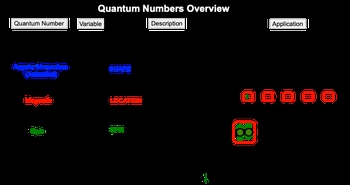So here we're going to have a quick review of the quantum numbers. So we're going to say, remember the quantum numbers are a set of values describe the energy levels and ultimately the location of a specific electron. Now here with our principal quantum number, our first one, its variable is N. It describes the size and energy of a shell. So for example, let's say we're dealing with a set of 7D orbitals. Because the number is 7, that means we're dealing with electrons in the 7th shell and therefore n=7.
The angular momentum quantum number, also called the azimuthal quantum number, uses the variable L. It gives us the shape of an orbital within a sub shell. Here subshells are sub levels. They are represented by the letters of S, P, D, and F. If you know the sublevel or subshell letter, then you know what your L value is. S is 0, P is 1, D is 2, and F is 3.
The magnetic quantum number deals with the variable M sub L. It gives us the location of electrons within a set of orbitals. So for example, let's say we're dealing again with 7D orbitals. Remember that your D sub level has five orbitals involved. Each of those orbitals has a number designation. So here this would be -2, -1, 0, +1, and +2. So those numbers are the M sub L values. They are the numerical location of each of these orbitals, and within each of those orbitals we have electrons.
Finally, we have our spin quantum number which is M sub S. It gives us the spin of an electron within an orbital. Remember an orbital can hold a maximum of two electrons. One spins up and would have an M sub S value of +12. The other one spins down and would have an M sub S value of -12.
So this is a crash course in quantum numbers if you didn't get a chance to look at my earlier videos. If you haven't, I highly suggest you go back and take a look. Quantum numbers can be a bit tricky, so it's important to understand these fundamental ideas on how they relate to the ultimate location of an electron within a given atom.


